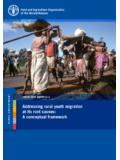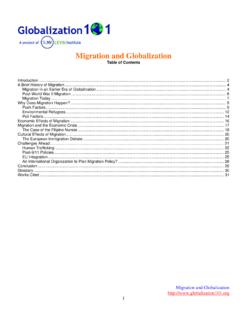Transcription of POPULATION AND MIGRATION - oecd.org
1 POPULATION TOTAL POPULATION FERTILITY DEPENDENT POPULATION POPULATION BY REGION ELDERLY POPULATION BY REGION INTERNATIONAL MIGRATION IMMIGRANT AND FOREIGN POPULATION TRENDS IN MIGRATION MIGRATION AND EMPLOYMENT MIGRATION AND UNEMPLOYMENT POPULATION AND MIGRATION TOTAL POPULATIONThe size and growth of a country s POPULATION are bothcauses and effects of economic and social pace of POPULATION growth has slowed in all projections, which give indications of likelychanges in the future POPULATION size and structure, are acommon demographic tool. They provide a basis forother statistical projections ( service provision,employment) and as such, they are a very valuable toolfor helping governments in their decision refer to the resident POPULATION , that is, they are ameasure of the POPULATION that usually lives in an countries with overseas colonies, protectorates orother territorial possessions, their populations aregenerally excluded.
2 Growth rates are the annual changesin the POPULATION resulting from births, deaths and netmigration during the working age POPULATION is those aged 15 to most OECD countries, POPULATION data are based onregular, ten-yearly censuses, with estimates forintercensal years derived from administrative data. Inseveral European countries, POPULATION estimates arebased entirely on administrative records. POPULATION dataare fairly some countries the POPULATION figures shown herediffer from those used for calculating GDP and othereconomic statistics on a per capita basis, althoughdifferences are normally projections are taken from national sourceswhere these are available, but for some countries theyare based on United Nations or Eurostat projections; theprojection for the world comes from the UN.
3 Allpopulation projections require assumptions about futuretrends in life expectancy, fertility rates and , a range of projections is produced using differentassumptions about these future trends. The estimatesshown here correspond to the median or central variant,OverviewIn 2010, OECD countries accounted for 18% of the world spopulation of billion. China accounted for 19% andIndia for 18%. Within the OECD, in 2010, the United Statesaccounted for 25% of the OECD total, followed by Japan(10%), Mexico (9%), Germany (7%) and Turkey (6%).In the three years to 2010, growth rates above the OECD POPULATION average ( per year) were recorded inIsrael, Mexico and Turkey (high birth rate countries) andin Australia, Canada, Chile, Luxembourg, Norway,Sweden, Switzerland, the United Kingdom and the UnitedStates (high net immigration).
4 New Zealand and Irelandalso recorded POPULATION growth rates above the OECD total which can be attributed to both a birth rate equal tothe replacement fertility rate (a total fertility rate of per woman) and a positive net MIGRATION Hungary and Germany, populations declined mostlydue to low birth rates. Growth rates were also negative inEstonia while they were very low, although still positive,in Japan, Poland, Portugal and the Slovak Republic. Thepopulation of OECD countries is expected to grow by lessthan per year until is; there is an estimated 50 percent chance thepopulation could be lower, and a 50 percent chance itcould be should be noted that in the case of Mexico, that thepopulation according to the POPULATION and HouseholdCensus taken in 2010 was million compared to theprevious estimate of million presented in the time series with the results of the POPULATION andHousing Census for Mexico is underway by the Ministry ofInterior.
5 As soon as data is available, it will be updated inthe digital version of the OECD For OECD member countries: national sources,United Nations and Eurostat. For Brazil, China, India, Indonesia, the RussianFederation and South Africa: POPULATION Division ofthe Department of Economic and Social Affairs ofthe United Nations Secretariat,World POPULATION Prospects: The 2010 Revision, UnitedNations, New informationAnalytical publications Bagnoli, P., T. Goeschl and E. Kovacs (2008),People and Biodiversity Policies: Impacts, Issues andStrategies for Policy Action, OECD Publishing. OECD (2011), Doing Better for Families, OECDP ublishing. OECD (2011), The Future of Families to 2030, publications Maddison, A. (2003),The World Economy: Historical Perspectives,Development Centre Studies, OECD Publishing.
6 OECD (2011),Society at a Glance: OECD Social Indicators, publications d Addio, and d Ercole (2005), Trends andDeterminants of Fertility Rates: The Role ofPolicies ,OECD Social Employment and MIGRATION Working Papers,No. 27. OECD (2011), Labour Force Statistics, OECD databases OECD Employment and Labour Market Statistics. United Nations World POPULATION Doing Better for Families (supplementary material), OECD Family Database, World Bank World Development Indicators, AND MIGRATION POPULATIONOECD Factbook 2013 OECD 2012 - Preliminary VersionPopulation levelsThousands2001200220032004200520062 007200820092010201120202050 Australia19 41319 65119 89520 12720 39520 69821 01521 49921 95522 29822 61825 28833 959 Austria8 0428 0828 1218 1728 2288 2698 3018 3378 3658 3908 4218 7249 360 Belgium10 28710 33310 37610 42110 47910 54810 62610 71010 79610 75813 139 Canada31 01931 35431 64031 94132 24532 57632 93033 31633 72034 34441 896 Chile15 57215 74615 91916 09316 26716 43316 59816 76316 92917 09417 24818 54920 205 Czech Republic10 23610 20510 20710 21610 23610 26910 33410 42410 48710 2879 457 Denmark5 3595 3765 3915 4055 4195 4375 4615 4945 5235 5825 621 Estonia1 3641 3591 3541 3491 3461 3441 3421 3411 3401
7 3281 250 Finland5 1885 2015 2135 2285 2465 2665 2895 3135 3395 3635 3885 6366 090 France59 47659 89460 30460 73461 18261 59761 96562 30062 62862 95963 29466 09872 341 Germany82 35082 48882 53482 51682 46982 37682 26682 11081 90281 91469 412 Greece10 95010 98811 02411 06211 10411 14811 19311 23711 28311 42610 605 Hungary10 18810 15910 13010 10710 08710 07110 05610 03810 02310 8568 718 Iceland285288289293296304311319319318319 345420 Ireland3 8663 9323 9974 0704 1604 2604 3574 4264 4594 7745 482 Israel6 4396 5706 6906 8096 9307 0547 1807 3097 4867 97757 15757 60558 17558 60758 94259 37559 83260 19360 00155 710 Japan127 291127 435127 619127 687127 768127 770127 771127 692127 510128 057127 799124 10097 076 Korea47 35747 62247 85948 03948 13848 37248 59848 94949 18249 41049 77951 43648 716100 909102 000103 002103 947104 874105 791106 683107 551108 396109 220115 762121 856 Netherlands16 04616 14916 22516 28216 32016 34616 38216 44616 53016 24017 343 New Zealand3 8813 9494 0274 0884 1344 1854 2284 2694 3164 3684 4054 5655 046 Norway4 5144 5384 5654 5924 6234 6614 7094 7684 8294 8894 9535 0615 854 Poland38 25138 23238 19538 18038 16138 13238 11638 11638 15338 83034 543 Portugal10 29310 36810 44110 50210 54910 58410 60810 62210 63210 83210 674 Slovak Republic5 3795 3795 3805 3825 3875 3915 3975 4075 4195 4174 880 Slovenia1 9921 9951 9961 9972 0002 0072 0102 0212 0402 0661 994 Spain40 72041 31442 00542 69243 39844 11644 87945 55645 90946 56842 703 Sweden8 8968 9258 9588 9949
8 0309 0819 1489 2209 2999 3789 4499 97610 726 Switzerland7 2277 2857 3397 3907 4377 4847 5517 6487 7447 3798 981 Turkey65 13366 00866 87367 72368 56669 39570 21571 07971 89772 25796 496 United Kingdom59 10859 32659 56659 03159 40859 75160 13760 54060 92761 34461 76166 75476 959 United States284 969287 625290 108292 805295 517298 380301 231304 094306 772309 330311 592341 387439 010EU27484 216485 641487 722489 966492 173494 251496 489498 686500 395501 792503 279514 913523 804 OECD1 158 2251 166 2861 174 2951 181 5631 189 5451 197 5951 205 8511 214 3661 221 9541 229 6901 231 7461 291 0871 393 722 Brazil173 808176 304178 741181 106183 383185 564187 642189 613191 481193 253194 933207 143215 288 China1 277 9041 285 9341 293 3971 300 5521 307 5941 314 5811 321 4821 328 2761 334 9091 341 3351 348 0101 387 7921 295 604 India1 071 3741 088 6941 105 8861 122 9911 140 0431 157 0391 173 9721 190 8641 207 7401 224 6141 241 9481 386 9091 692 008 Indonesia216 204219 026221 839224 607227 303229 919232 462234 951237 415239 871242 206262 570293 456 Russian Federation146 162145 520144 881144 307143 843143 510143 295143 163143 064142 958142 823141 022126 188 South Africa45 39046 01546 63147 22747 79348 33148 84249 31949 75250 13350 38552 57356 757 World6 200 0036 276 7226 353 1966 429 7586 506 6496 583 9596 661 6386 739 6116 817 7376 895 8896 975 1147 656 5289 306 128 Statlink populationMillions, 2010 Statlink populationMillions.
9 2010 Statlink AND MIGRATION POPULATIONOECD Factbook 2013 OECD 2012 - Preliminary VersionPopulation growth ratesAnnual growth in growth ratesAverage annual growth in percentageStatlink AND MIGRATION POPULATIONOECD Factbook 2013 OECD 2012 - Preliminary VersionWorking age populationAs a percentage of total age populationAs a percentage of total populationStatlink AND MIGRATION POPULATIONOECD Factbook 2013 OECD 2012 - Preliminary VersionFERTILITYT ogether with mortality and MIGRATION , fertility is anelement of POPULATION growth, which reflects both thecauses and effects of economic and social total fertility rate in a specific year is the totalnumber of children that would be born to each woman ifshe were to live to the end of her child-bearing years andgive birth to children in agreement with the prevailingage-specific fertility total fertility rate is generally computed by summingup the age-specific fertility rates defined over a five-yearinterval.
10 Assuming there are no MIGRATION flows and thatmortality rates remain unchanged, a total fertility rate children per woman generates broad stability of thepopulation: it is also referred to as the replacementfertility rate as it ensures replacement of the womanand her partner with another children per woman tocounteract infant are collected every year from national statisticalinstitutes. 2010 refers to 2009 for Canada and Chile and1970 refers to 1980 for Brazil, Estonia and fertility rates in OECD countries have declineddramatically over the past few decades, falling onaverage from in 1970 to children per woman ofchildbearing age in the 2000s. In all OECD countries,fertility rates declined for young women and increased atolder ages.

















